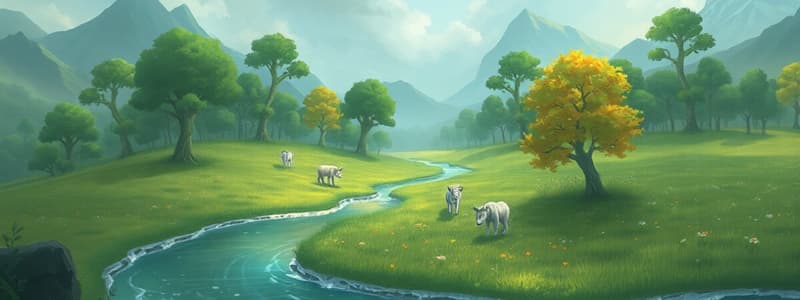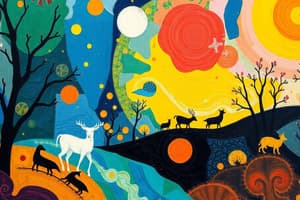Podcast
Questions and Answers
Which of the following are reasons a population may increase?
Which of the following are reasons a population may increase?
- Increased predation
- Scarcity of resources
- Immigration (correct)
- Abundant food (correct)
What defines a keystone species?
What defines a keystone species?
- Any organism in a food chain
- A species that has a high reproductive rate
- A species that the ecosystem profoundly depends on (correct)
- A non-native species that disrupts the ecosystem
What is the maximum number of individuals an environment can support called?
What is the maximum number of individuals an environment can support called?
- Biological limit
- Ecosystem threshold
- Carrying capacity (correct)
- Population density
Which of the following is an example of a limiting factor?
Which of the following is an example of a limiting factor?
Which cycle does NOT pass through the atmosphere as a gas?
Which cycle does NOT pass through the atmosphere as a gas?
What occurs during the process of nitrogen fixation?
What occurs during the process of nitrogen fixation?
What effect does high levels of carbon dioxide in the atmosphere generally cause?
What effect does high levels of carbon dioxide in the atmosphere generally cause?
What happens in a predator-prey relationship when the predator population increases?
What happens in a predator-prey relationship when the predator population increases?
Flashcards
What is an invasive species?
What is an invasive species?
A non-native species that causes ecological problems.
What is carrying capacity?
What is carrying capacity?
The maximum number of individuals an environment can support.
What are limiting factors?
What are limiting factors?
Factors that limit the growth of a population.
What is nitrogen fixation?
What is nitrogen fixation?
Signup and view all the flashcards
What is denitrification?
What is denitrification?
Signup and view all the flashcards
What is a keystone species?
What is a keystone species?
Signup and view all the flashcards
What is a trophic cascade?
What is a trophic cascade?
Signup and view all the flashcards
How does phosphorus get into the soil?
How does phosphorus get into the soil?
Signup and view all the flashcards
Study Notes
Population Growth
- Populations can increase due to immigration, abundant food/space, and fewer predators.
- Invasive species are non-native species causing ecological problems.
- Carrying capacity is the maximum number of individuals an environment can support.
- Carrying capacity occurs during phase III of a population graph.
- Limiting factors include predation, emigration, competition, natural disasters, and human activity.
Predator-Prey Relationships
- Predator populations increasing leads to prey populations decreasing, and vice versa.
- Keystone species are crucial to an ecosystem, affecting many other species. Examples include sea otters and Yellowstone gray wolves.
Trophic Cascades
- Removing a keystone species drastically alters the ecosystem. For example, removing gray wolves led to an elk population increase and a subsequent decline in plant populations.
Carbon Cycle
- Four ways carbon dioxide enters the atmosphere are respiration, decomposition, volcanic eruptions, and burning fossil fuels.
- Photosynthesis is the primary use of carbon dioxide.
- Too much carbon dioxide causes the greenhouse effect, leading to global warming.
Nitrogen Cycle
- Only bacteria can convert atmospheric nitrogen to gas form.
- Nitrogen is essential for making proteins.
- Free nitrogen in the atmosphere is converted to usable nitrogen compounds through processes like nitrogen fixation (bacteria) and denitrification (bacteria).
- Nitrogen compounds are found in nitrates, and used by plants as a nutrient.
- Consumers obtain nitrogen by eating plants or other organisms.
Phosphorus Cycle
- Phosphate is added to the soil through erosion and weathering.
- The phosphorus cycle doesn't involve the atmosphere as a phase.
Studying That Suits You
Use AI to generate personalized quizzes and flashcards to suit your learning preferences.



